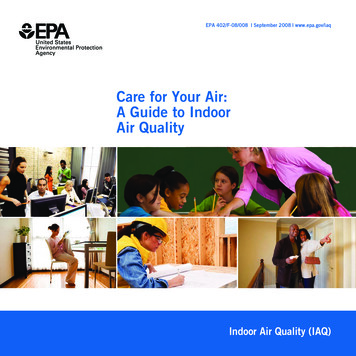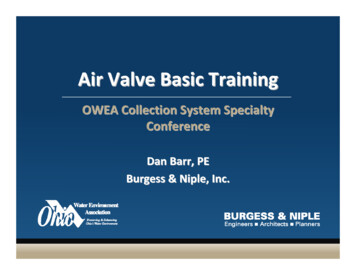
Transcription
EPA 402/F-08/008 September 2008 www.epa.gov/iaqCare for Your Air:A Guide to IndoorAir QualityIndoor Air Quality (IAQ)
Understand indoor air inhomes, schools, and officesMost of us spend much of our time indoors. Theair that we breathe in our homes, in schools, andin offices can put us at risk for health problems.Some pollutants can be chemicals, gases, andliving organisms like mold and pests.Several sources of air pollution are in homes,schools, and offices. Some pollutants cause healthproblems such as sore eyes, burning in the noseand throat, headaches, or fatigue. Other pollutantscause or worsen allergies, respiratory illnesses(such as asthma), heart disease, cancer, andother serious long-term conditions. Sometimesindividual pollutants at high concentrations, suchas carbon monoxide, cause death.Some pollutants in the air areespecially harmful for children,elderly people, and those withhealth problems.
Learn about pollutantsUnderstanding and controlling some of the commonpollutants found in homes, schools, and offices may helpimprove your indoor air and reduce your family’s risk ofhealth concerns related to indoor air quality (IAQ).Radon is a radioactive gas that is formed in the soil. It canenter indoors through cracks and openings in floors andwalls that are in contact with the ground. Radonis the leading cause of lung cancer amongnonsmokers, and the second leading cause of lung canceroverall.Secondhand smoke comes from burning tobacco products.It can cause cancer and serious respiratory illnesses. Childrenare especially vulnerable to secondhand smoke.It can cause or worsen asthma symptoms and is linked toincreased risks of ear infections and Sudden Infant DeathSyndrome (SIDS).Combustion Pollutants are gases or particles that comefrom burning materials. In homes, the major source ofcombustion pollutants are improperly vented or unventedfuel-burning appliances such as space heaters, woodstoves,gas stoves, water heaters, dryers, and fireplaces. The typesand amounts of pollutants produced depends on the type ofappliance, how well the appliance is installed, maintained,and vented, and the kind of fuel it uses. Commoncombustion pollutants include: Carbonmonoxide (CO) which is a colorless, odorlessgas that interferes with the delivery of oxygenthroughout the body. Carbon monoxide causesheadaches, dizziness, weakness, nausea, and even death. Nitrogendioxide (NO2) which is a colorless, odorlessgas that causes eye, nose and throat irritation, shortnessof breath, and an increased risk of respiratory infection.Volatile organic compounds (VOCs) are chemicals foundin paints and lacquers, paint strippers, cleaning supplies,varnishes and waxes, pesticides, building materialsand furnishings, office equipment, moth repellents, airfresheners, and dry-cleanedclothing. VOCs evaporate intothe air when these products areused or sometimes even whenthey are stored. Volatileorganic compoundsirritate the eyes, nose andthroat, and cause headaches,nausea, and damage to theliver, kidneys, and centralnervous system. Some of them can cause cancer.Asthma triggers are commonly found in homes, schools,and offices and include mold, dust mites, secondhandsmoke, and pet dander. A home may have mold growing ona shower curtain, dust mites in pillows, blankets or stuffedanimals, secondhand smoke in the air, and cat and doghairs on the carpet or floors. Other common asthma triggersinclude some foods and pollutants in the air. Asthmatriggers cause symptoms including coughing,chest tightness, wheezing, and breathing problems. Anasthma attack occurs when symptoms keep getting worseor are suddenly very severe. Asthma attacks can be lifethreatening. However, asthma is controllable with theright medicines and by reducing asthma triggers.Molds are living things that produce spores. Molds producespores that float in the air, land on damp surfaces, and grow. Inhalingor touching molds can cause hay fever-typesymptoms such as sneezing, runny nose, red eyes, andskin rashes. Molds can also trigger asthma attacks.www.epa.gov/iaq
Improving your airTake steps to help improve your air quality and reduce yourIAQ-related health risks at little or no cost by:exhaust to the outdoors also increase ventilation and helpremove pollutants.Controlling the sources of pollution: Usually themost effective way to improve indoor air is to eliminateindividual sources or reduce their emissions.Always ventilate and follow manufacturers’ instructionswhen you use products or appliances that may releasepollutants into the indoor air.Ventilating: Increasing the amount of fresh air broughtindoors helps reduce pollutants inside. When weatherpermits, open windows and doors, or run an air conditionerwith the vent control open. Bathroom and kitchen fans thatChanging filters regularly: Central heaters and airconditioners have filters to trap dust and other pollutants inthe air. Make sure to change or clean the filters regularly,following the instructions on the package.Important tips that will help control indoorpollutants Test for radon and fix if there is a problem. Reduce asthma triggers such as mold and dustmites. Do not let people smoke indoors. Keep all areas clean and dry. Clean up any mold andget rid of excess water or moisture. Always ventilate when using products that canrelease pollutants into the air; if products must bestored following use, make sure to close tightly. Inspect fuel-burning appliances regularly for leaks,and make repairs when necessary. Consider installing a carbon monoxide alarm.Adjusting humidity: The humidity inside can affect theconcentrations of some indoor air pollutants. For example,high humidity keeps the air moist and increases thelikelihood of mold.Keep indoor humidity between 30 and 50 percent. Use amoisture or humidity gauge, available at most hardwarestores, to see if the humidity in your home is at a goodlevel. To increase humidity, use a vaporizer or humidifier.To decrease humidity, open the windows if it is not humidoutdoors. If it is warm, turn on the air conditioner or adjustthe humidity setting on the humidifier.
Remodeling old homes and building new homesWhile remodeling or improving the energy efficiency ofyour home, steps should be taken to minimize pollutionfrom sources inside the home, either from new materials orfrom disturbing materials already in the home. In addition,residents should be alert to signs of inadequate ventilation,such as stuffy air, moisture condensation on cold surfaces,or mold and mildew growth.When building new homes, homebuyers today areincreasingly concerned about the IAQ of their homes.Pollutants like mold, radon, carbon monoxide, and toxicchemicals have received greater attention than ever aspoor IAQ has been linked to a host of health problems.To address these concerns, builders can employ a varietyof construction practices and technologies to decrease therisk of poor IAQ in their new homes using the criteria fromEPA’s Indoor airPLUS as a guide.To help ensure that you will have good IAQ in your new orremodeled home: Askabout including radon-reducing features. Provideproper drainage and seal foundations in newconstruction. Considerinstalling a mechanical ventilation system.Mechanical ventilation systems introduce fresh air usingducts and fans, instead of relying on holes or cracks inthe walls and windows. Wheninstalling new appliances (like furnaces) makesure they are installed properly with a good vent or flue.
SchoolsWith nearly 56 million people, or 20 percent of the U.S. population, spending their days inside elementary and secondaryschools, IAQ problems can be a significant concern. All types of schools—whether new or old, big or small, elementaryor high school—can experience IAQ problems. School districts are increasinglyexperiencing budget shortfalls and many are in poor condition, leading to a host ofIAQ problems. EPA’svoluntary Indoor Air Quality Tools for Schools Program provides districtbased guidance to schools about best practices, industry guidelines, and practicalmanagement actions to help school personnel identify, solve, and prevent IAQproblems. Childrenmay be more sensitive to pollution, and children with asthma areespecially sensitive. Asthma is responsible for millions of missed school days eachyear. Parents’ and caregivers’ involvement helps daycare facilities become awareof asthma triggers and the need to reduce them.Office BuildingsMany office buildings have poor IAQ because of pollution sourcesand poorly designed, maintained, or operated ventilation systems. Officeworkers help to improve the indoor air in their buildingsby paying attention to environmental conditions includingventilation, temperature, and the presence of odors. Report anyproblems to facility managers immediately. Toimprove IAQ, be careful not to block air vents or grilles,keep your space clean and dry, and do not bring in products thatmay pollute the indoor air.Unfold this brochure to find a poster that tells you how to improve the air you breathe in your home.www.epa.gov/iaq
Take Action to Improve Air Quality in Every RoomAsthma is a serious, sometimes life-threateningrespiratory disease that affects the quality of life formillions of Americans.Mold can lead to allergic reactions, asthma, and otherrespiratory ailments.Mold: can grow anywhere there is moisture in a house.Environmental asthma triggers: are found around the home andcan be eliminated with simple steps. Don’t Dustmold is a problem in your home, you should clean up the moldpromptly and fix the water problem.and clean your home regularly.up mold and fix water leaks. Washsheets and blankets weekly in hot water.key to mold control is moisture control. Ifallow smoking in your home or car. Clean Use The Itis important to dry water-damaged areas and items within 24-48hours to prevent mold growth.allergen-proof mattress and pillow covers. Keeppets out of the bedroom and off soft furniture.VOCs cause eye, nose, and throat irritation, headaches,nausea, and can damage the liver, kidney, and centralnervous system. Controlpests—close up cracks and crevices and seal leaks;don’t leave food out.Volatile organic compounds (VOCs): are chemicals that evaporateat room temperature. VOCs are emitted by a wide array of productsused in homes including paints and lacquers, paint strippers,varnishes, cleaning supplies, air fresheners, pesticides, buildingmaterials, and furnishings. VOCs are released from products into thehome both during use and while stored.Children are especially sensitive to secondhandsmoke, which can trigger asthma and otherrespiratory illnesses.Secondhand smoke: smoke comes from burning tobaccoproducts such as cigarettes, pipes, and cigars. Read To Makeand follow all directions and warnings on commonhousehold products.help protect children from secondhand smoke, do notsmoke or allow others to smoke inside your home or car.sure there is plenty of fresh air and ventilation (e.g., openingwindows and using extra fans) when painting, remodeling, orusing other products that may release VOCs. Nevermix products, such as household cleaners, unless directed todo so on the label. Storehousehold products that contain chemicals according tomanufacturers’ instructions.Radon is the second leading cause of lung cancer. KeepRadon gas: enters your home through cracks and openings infloors and walls in contact with the ground.all products away from children! Testyour home with a do-it-yourself radon kit. If the testresult indicates you should fix, call a qualified radon mitigationspecialist.Carbon monoxide causes headaches, dizziness,disorientation, nausea and fatigue, and high levels canbe fatal. Askyour builder about including radon-reducing features inyour new home at the time of construction.Nitrogen dioxide causes eyes, nose, and throatirritation, impairs lung function, and increasesrespiratory infections.Sources include: indoor use of furnaces, gas stoves, unventedkerosene and gas space heaters, leaking chimneys, and tobaccoproducts. Ventilate Userooms where fuel-burning appliances are used.appliances that vent to the outside whenever possible. Ensurethat all fuel-burning appliances are properly installed, used,adjusted, and maintained.Visit www.epa.gov/iaq
Keep indoor humidity between 30 and 50 percent. Use a moisture or humidity gauge, available at most hardware stores, to see if the humidity in your home is at a good level. To increase humidity, use a vaporizer or humidifier. To decrease humidity, open the windows if it is not humid outdoors. If it is warm, turn on the air conditioner or adjust











